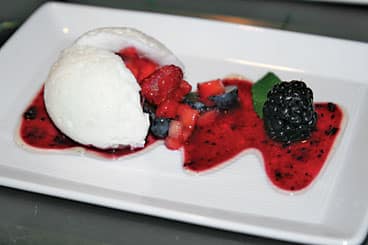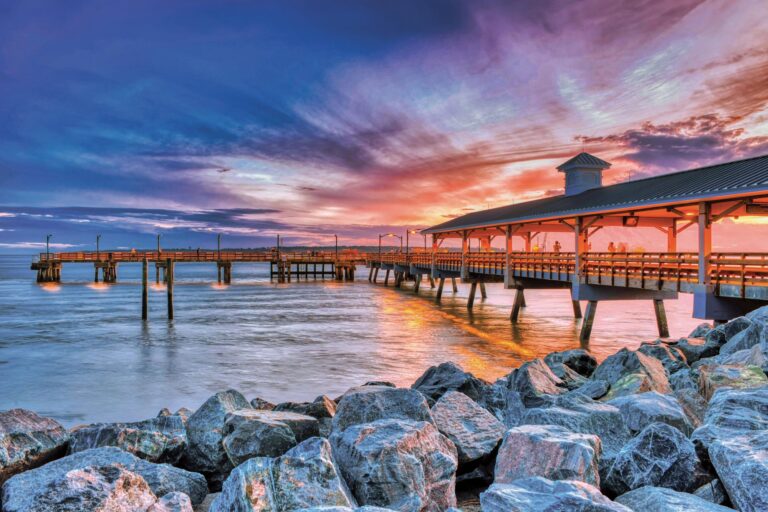
St. Barths
“This is an apple tartlet with almond crust,” chef Anna-Maria Zorgman says with a smile as she places the small plate of nature’s sweetness on the table before me. “And there is a kuzu glaze on top. This will help with your digestion.”
I don’t quite know what to make of that last sentence. Typically, when I’m aboard charter yach`ts with weekly base rates in the $100,000 range, the chefs proudly introduce desserts that include the phrases “chocolate lava” and “whipped decadence,” words that seem laden with calories before I even dip my fork into the gooey concoctions. I’ve never heard of kuzu (it’s apparently a fan favorite of traditional medicine men in China), and I’ve never before been asked to consider my digestion after a three-course gourmet dinner on the afterdeck of a luxurious yacht. Usually, I’m stuffed like a piñata full of fats and sugars, then sent off to a bed whose very form seems challenged by the sheer number of throw pillows atop it. I spend more time than is humanly tolerable fumbling with air-conditioning controls and TV remotes, trying desperately to find comfort and rest within my own gluttonous skin.
Not so aboard the 114-foot Sunreef Che (see the complete photo gallery here). After I finish my apple tartlet, I make my way down to my cabin, where the berth is covered in crisp white linens, a single oversize pillow and precisely one lightweight blanket woven in the soothing shade of eggplant. There’s no artwork on the walls, only the natural beauty in panel after panel of bamboo wood. I sink into the memory-foam mattress, feel the Caribbean breeze flowing through the open hatch and hear nothing but the gentle surf, since the crew turns off the generator each night at anchor. I feel satisfied. I feel content. I fall asleep in less than five minutes, thinking about the offerings I saw to the Buddha statue up in the main salon.

Until this kuzu evening, I had never before considered just how much the word luxury has become synonymous with the word heavy. All of my previous yacht charter experiences suddenly feel so encumbered, so complicated, so clearly thick with unnecessary accoutrements in décor and diet. What I discovered aboard Che is truly unique, not so much a vacation as a chance to experience a different way of life. She will be easily marketed as a luxury yacht offering top-notch spa-style charters — which she does, with twin-size berths in every cabin for groups of friends traveling together — but she is also, in fact, far more. Che is infused with the meaning of her name, the balance that comes with the perfect blending of yin and yang. Being aboard made me feel, in a word, light, which is really saying something given that she is, at this writing, the largest sloop-rigged catamaran in the world.
She launched in July 2010 and boasts a beam of 42 feet, which, in case you’re counting, is just a smidge wider than the beam aboard the jaw-dropping, 288-foot Perini Navi Maltese Falcon. Che displaces 115 tons and has a mainsail that’s nearly 4,200 square feet, giving her a maximum speed of 25 knots. It is truly awesome to watch Capt. Daniel Rabasse propel her through wind and waves. We reached only about 12 knots as we cruised from St. Maarten to St. Barths during the notorious Christmas Winds, but even that speed made it feel like Che was absolutely flying.
Yet, she also felt as though she was barely moving, with a heeling angle so subtle that it’s almost indiscernible, compared with a monohull’s. Che‘s balance is evident when she’s under power too, a fact I discovered while in the aft starboard cabin my first afternoon aboard. I was literally at the waterline, taking a shower, and didn’t even feel or hear Che moving. The only reason I knew that Rabasse had turned on the engines, raised the anchor and throttled forward is that we were in an entirely different harbor when I returned to the afterdeck about 20 minutes later.

It’s on that afterdeck that I got to know Zorgman, a South African native whose cooking style and world view have evolved along with those of Che‘s owners. While Zorgman says she will cook whatever guests desire, her specialty is the owners’ preferred regimen: macrobiotic.
“Macrobiotic means to look at the larger picture of life, to see how we came to be,” she says. “It starts with the food we eat. Things like hypoglycemia, these are modern illnesses that come because we are eating to extreme. Macrobiotic food goes very well with the yin-yang of this boat. After two to four weeks of this diet, it feels like a cloud lifting off your head. You have clarity. Everything is functioning better.”
Our weeklong charter was more like a quick-hit cleanse, one filled with foods that were at once old and new. The macrobiotic food pyramid, which is really more of a starburst, centers around whole grains like brown rice and pearl barley. You’re allowed a good bit of green, leafy vegetables such as broccoli, kale and celery stalks, as well as beans, peas and lentils. Vegetables that are considered round, ground or root are also approved. They include radishes, yams and cauliflower.
On the “avoid or limit” list are all forms of meat and poultry, fatty fishes such as tuna and salmon, shellfish like seafood and lobster, all forms of dairy including butter and cheese, sweets such as sugar, molasses and honey, “nightshade” vegetables including tomatoes, potatoes and peppers, tropical fruits like bananas, mangoes and avocados, and anything with processed soy, as well as coffee, black tea and alcohol.
That’s not to say we didn’t have any of those things — Zorgman’s tomato-laced bruschetta and salads with avocado were delicious, and Che‘s owner has an impressive wine collection that is available to charter guests — but most of the food on our plates came from whole cereals, leafy green stuff and root vegetables. Every morning began with miso soup eaten by tipping the bowls to our lips with our hands, to cleanse the intestines for the day ahead. Then each day unfolded with offerings like freshly made celery and beet-root juices, mushroom-filled wontons served with a salad of hijiki (a type of seaweed), red-snapper sashimi, gnocchi-style butternut squash and Vietnamese pancakes in rice paper. When our group asked for bloody mary cocktails, Zorgman prepared them with freshly squeezed tomato juice, making them taste like health food too.

“I will cook whatever people want, but I also like to introduce people to this new way of cooking and eating,” Zorgman says. “I love fish, and I love vegetarian dishes. I come from a traditional French and Italian approach, but now I am much more interested in Asian cuisine. It’s the healthiest food in the world.”
I’ll admit to sneaking a mozzarella panini, a small chocolate bar and a cold beer one afternoon on St. Barths, but I otherwise stuck with Zorgman’s regimen, and as I said, I felt absolutely light. Everyone on the boat felt the same after about 48 hours, almost childlike and free, as evidenced by our playtime at Shell Beach during our last afternoon on board. Three of us women, all easily described as middle-age if we’re being honest, climbed out onto the forward tips of Che‘s pontoons and trampolines. We balanced ourselves a good 15 feet above the water, which sparkled with the clean blues and greens of an outgoing tide. The breeze blew our hair back, and the sunbeams shone on our cheeks. We counted calmly, and in unison, to three.
And then we leapt, with great joy, into the refreshing embrace of nature.
Che is part of the charter fleet at Sunreef Yachts. She can accommodate eight guests with five crew at a lowest weekly base rate of around $96,000. Contact 954-232-6852; www.sunreef-charter.com.








